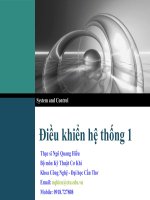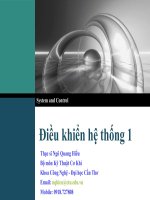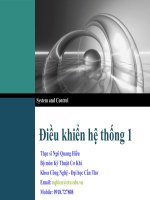điều khiển hệ thống nhà thông minh
Bạn đang xem bản rút gọn của tài liệu. Xem và tải ngay bản đầy đủ của tài liệu tại đây (642.97 KB, 60 trang )
Intelligent Buildings
Technology
Intelligent Buildings Technology
Introduction-Energy Management
Energy used in buildings accounts for almost half
of the total amount of energy consumed in the
European Community today.
Almost 85% of the energy used in buildings is for
low temperature applications such as space and
water heating.
Appropriate building designs involving clean and
efficient technologies are already available and
there use may help to reduce future energy
consumption as well as to provide a better quality
of life for citizens.
Intelligent Buildings Technology
Introduction-Energy Management
With fossil fuels the primary energy source, the building
sector currently produces 22% of total CO2 emissions in
the EC. This is more than that produced by the
industrial sector.
Intelligently designed buildings are those that involve
environmentally responsive design taking into account
the surroundings and building usage and involving the
selection of appropriate building services and control
systems to further enhance building operation with a
view to the reduction of energy consumption and
environmental impact over its lifetime.
Intelligent Buildings Technology
Energy in Buildings
Buildings are inherently linked to their usage and
surroundings and hence their indoor environment is the
result of a range of interactions affected by seasonal and
daily changes in climate and by the requirements of
occupants varying in time and space.
The design of buildings in the mid-late twentieth century
has sought to eliminate the effect of outdoor daily and
seasonal changes through the use of extensive heating,
cooling, lighting and ventilation equipment, resulting in
spiraling energy consumption and environmental impact.
Intelligent Buildings Technology
Energy in Buildings
A more climate sensitive approach linked to the use of
advanced control systems allows the building occupants to
control their indoor environment whilst maximising the
contribution of ambient energy sources to the creation of a
comfortable indoor environment through the use of a more
climate sensitive design approach.
Under almost all circumstances it is necessary at some point
in time to provide some form of auxiliary heating, cooling,
lighting or ventilation since natural sources cannot always
cover the requirements for thermal comfort, visual comfort
and IAQ that are the prerequisite for a well balanced,
comfortable and healthy indoor environment.
Intelligent Buildings Technology
Energy in Buildings
The purpose of energy management in buildings, and
hence the role of the building energy manager, is to
identify the areas in building stock where energy is used
in excess.
Energy consumption in building is required for the
following uses:
Heating
Cooling
Ventilation
Lighting
Equipment and machinery
Domestic hot water
Intelligent Buildings
Technology
Indoor Comfort
Thermal comfort
Visual Comfort
Indoor air quality
Thermal Comfort
Intelligent Buildings Technology
Thermal Comfort
Comfort is defined as the sensation of complete physical and
mental well being.
Thermal neutrality, where an individual desires neither a warmer
nor a colder environment, is a necessary condition for thermal
comfort.
The factors affecting comfort are divided into personal variables:
activity
Clothing
and environmental variables,
(air temperature,
mean radiant temperature
air velocity
air humidity
Intelligent Buildings Technology
Thermal Comfort – Energy Balance
Intelligent Buildings Technology
Thermal Comfort – Personal Variables
Clothing: describes the occupant’s thermal insulation against the
environment. This thermal insulation is expressed in clo units.
Intelligent Buildings Technology
Thermal Comfort – Personal Variables
Activity: The metabolic rate is the amount of energy produced per unit of time by the conversion
of food. It is influenced by activity level and is expressed in mets (1 met = seated relaxing
person).
Intelligent Buildings Technology
Thermal Comfort – Environmental Variables
Temperature
The average air temperature from the floor at a height of 1.1 m.
Mean Radiant Temperature
The average temperature of the surrounding surfaces, which includes the effect of the incident solar radiation.
Air Velocity
Which affects convective heat loss from the body, i.e. air at a greater velocity will seem cooler.
Air Humidity
Which affects the latent heat losses and has a particularly important impact in warm and humid environments
Intelligent Buildings Technology
Thermal Comfort – Indices
Although the four parameters of air temperature, radiant
temperature, relative humidity and air movement are
generally recognized as the main thermal comfort
parameters, indoor environmental conditions in terms of
thermal comfort can generally be assessed through three
classes of environmental indices, namely:
Direct indices
Rationally derived indices
Empirical indices
Intelligent Buildings Technology
Thermal Comfort – Indices
Direct indices
dry-bulb temperature
dew-point temperature
wet-bulb temperature
relative humidity
air movement
Rationally derived indices
mean radiant temperature
operative temperature
heat stress, and
thermal stress
Empirical indices
Intelligent Buildings Technology
Thermal Comfort – PMV Index
The perceived need for both heating and cooling is to achieve
accepted standards of thermal comfort, usually defined (directly or
indirectly) by temperature limits.
Controversy exists as to what these standards of thermal comfort
are. It has been observed that there has been an apparent
discrepancy between comfort predictions using models derived from
laboratory experiments, such as those by Fanger (1970), and
subjective assessments of comfort found in field studies. It has
been found – in a compilation of results from field studies in
predominantly in warm and hot climates by Humphreys (1978) that
the preferred comfort temperature in buildings was a function of the
average monthly outdoor temperature (To is the mean monthly
temperature):
Intelligent Buildings Technology
Thermal Comfort – PMV Index
The Predicted Mean Vote (PMV) is a widely accepted
mathematical expression of thermal comfort. This index is
a real number and comfort is obtained if it lies within the
specific limits of the comfort range. Since 1984, the index
– which is calculated through a complex mathematical
function of human activity, clothing and environmental
parameters – has been the basis of the international
standard ISO-7730.
This PMV is an index which predicts the mean value of
the votes of a large group of people, and is directly related
to the percentage of people dissatisfied (PPD), on the
following seven point thermal sensation scale: + 3 Hot, + 2
Warm, + 1 Slightly Warm, 0 Neutral, - 1 Slightly Cool, - 2
Cool, - 3 Cold.
Intelligent Buildings Technology
Thermal Comfort – PMV Index
Intelligent Buildings Technology
Thermal Comfort – PMV Index
The result of using Fanger’s equations seems to predict the need for
much more closely controlled conditions than are usually found in free
running buildings, in which people still seem to be comfortable. Some
of the possible explanations for the apparent discrepancy between the
prediction of the Fanger model and the findings of the Humphreys’
survey, are:
The thermal comfort parameters, air temperature, radiant temperature
and air movement vary spatially in a room, and the actual values
experienced by an occupant may not be those described by a "roomaverage value".
Thermal comfort parameters vary with time whereas the Fanger
model predicts a response for steady conditions.
The description of clothing level assumed in the use of the Fanger
equation may not be the same as is actually worn in the real situation.
The insulation value of the clothing may not be as predicted from the
description of the clothing ensemble.
The metabolic rate as assumed from the description of the activity
may not be the same as the actual metabolic rate.
Visual comfort
Intelligent Buildings Technology
Visual Comfort
Visual comfort is the main determinant of lighting
requirements.
Good lighting provide a suitable intensity and direction of
illumination on the task area, appropriate colour rendering,
the absence of discomfort and, in addition, a satisfying
variety in lighting quality and intensity from place to place
and over time.
People’s lighting preferences vary with age, gender, time
and season. The activity to be performed is critically
important.
Various agencies (ASHRAE, CIBSE, etc.) and text books
list optimal illuminances for different activities. These are
generally based on uniform and constant levels of artificial
light falling on the working plane.
Intelligent Buildings Technology
Visual Comfort – Illuminance levels
Intelligent Buildings Technology
Visual Comfort
Natural light is a fluctuating source of light. It depends on the hour of
the day, the season, the climate and the latitude of the location.
The objective of a daylight technique consists of providing the best
possible indoor luminous environment as often as possible.
A luminous environment should be appropriate to the function of the
room: there should be enough light for reading, writing, or filing
documents.
Illuminance of 300 to 400 lux on a desk are often considered as
minimum required levels for most of office tasks. Hallways might
require lower levels, 100 lux, and commercial centres higher levels,
700 lux. These requirements are defined by CIE.
Performance does not depend only on these illuminance levels. The
location of the source of light with respect to the direction of
observation may require higher illuminance, for instant when the
observer faces a window.
Intelligent Buildings Technology
Visual Comfort
The luminous environment should be comfortable, which
means that sources of glare should be avoided.
Oversized glazed windows with clear glazing are sources
of glare, and this can be fought in using multiple apertures,
if possible on different walls.
Glossy materials and inappropriate shading devices might
bring excessive amount of light in the field of vision.
Also, psychological aspects such as the quality of the
vision to the outside, the beauty of the design and the
attractiveness of the space are very important.
Intelligent Buildings Technology
Visual Comfort
Natural light comes from three
directions:
Direct Sunlight
Diffuse light from the sky,
and
Light Reflections from the
Environment









